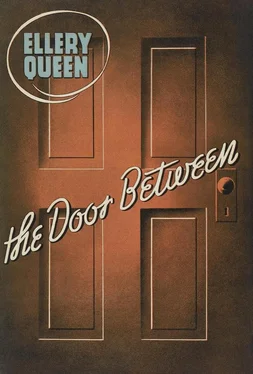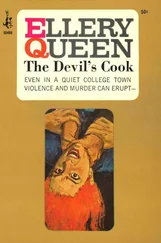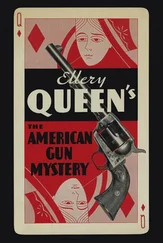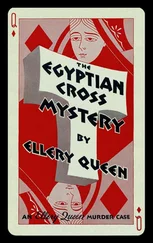“It’s a nice point — really beautiful; perfect symmetry. What was Karen Leith? Well, her skin was white, but its underside had turned yellow. She had lived so long in Japan, loved so deeply things Japanese, that she had become more than half Japanese. Consider how she lived in Washington Square — in quarters nostalgic for Japan, Japanese furniture, art, decorations; even her garden was Japanese. At every opportunity she wore Japanese dress. She loved Japanese customs — do you remember that ceremonious tea? She had been brought up in a semi-Japanese home, had associated with Japanese friends, with Japanese servants, had taught Japanese students at the Imperial University after her father’s death. In a sense, she was a convert to the spirit of Japan — it isn’t difficult to think of her as mentally and psychologically more Japanese than Occidental. As a matter of fact, there have been numerous instances of Westerners becoming converted to Japan — do you remember Lafcadio Hearn, for instance?
“Now if you consider Karen Leith in this light, what is suggested by the specific conditions of her death: dressed in a Japanese kimono, her throat cut, the weapon a thing of steel and crusted with gems? Eh? Why, a half-hour or so before her death, did she change from ordinary Western dress — as Kinumé will tell you — to the kimono? How explain the rather delicately grim choice of death — a cutting of the throat? Why that specific weapon — half of a begemmed Japanese scissors, which in the absence of a ‘jeweled dagger’ can easily be visualized as such? I’ll tell you why.” Ellery waved his pince-nez . “Because these three elements — jeweled dagger, cut throat, and kimono — are mandatory in the age-old Japanese ceremony of hara-kiri . And hara-kiri is the age-old Japanese ceremony of suicide.”
“No,” said the Inspector stubbornly after a moment. “No! That’s not so. I don’t know a lot about it, but I do know that this hara-kiri business isn’t throat-cutting. I heard of a case of a Jap a few years ago who did it by disembowelment. I looked it up then. They always slash their abdomens.”
“This Japanese was a man?” demanded Ellery.
“Yes.”
“You didn’t look into it deeply enough. I did. Male Japanese suicides cut their abdomens open. Females their throats.”
“Oh,” said the Inspector.
“But that isn’t all. Hara-kiri isn’t promiscuous; it must have narrow and specific motivation. It’s all neatly tied up with honor. You do not take your life by hara-kiri lightly in Japan. It’s only when you’ve committed a dishonorable act. This ritual form of suicide wipes out the dishonor — at least, that’s the aesthetics of it. But how about Karen Leith? Didn’t she have a dishonor to wipe out — the theft of her sister’s genius? And didn’t she die on a little step — the edge of the dais before the oriel windows — which makes it easy to visualize her as kneeling ? But that’s another requirement in hara-kiri , you see.
“No, no. One, or even two, of these five indications — except the last — would have meant little. But with this last and the other four to bolster it, a theory of suicide is erected which simply cannot be disregarded.”
They were silent.
At last the Inspector exclaimed: “But there’s no confirmation , there’s no evidence , there’s no proof . It’s only a theory. I can’t let Miss MacClure out on an unsupported theory. Be reasonable!”
“I’m being the soul of reason,” sighed Ellery.
“And then where’s the missing half of the scissors with which you say she killed herself?” The old man rose, shaking his head. “It’s no go, Ellery. You’ve got a pretty theory with a hole in it, and I’ve got a theory with evidence to back it up.”
“Look,” said Ellery. “Had you found that missing half-scissors with its identifying broken point near Karen’s body, with all the other conditions remaining the same , wouldn’t you have accepted a theory of suicide? Would the mere presence of Eva MacClure in the next room have convinced you it was murder?”
“But we didn’t find the weapon by the body, you see. I mean the real weapon — not the other half with Miss MacClure’s fingerprints on it.”
“You want proof.”
“That’s what the jury will want,” said the Inspector apologetically. “Even before that, that’s what the District Attorney will want. You’ll have to satisfy Henry Sampson, not me.”
It sounded final. Eva relaxed against Terry hopelessly.
“In other words,” continued Ellery in a murmur, “I’ve got to do two things: explain why the weapon wasn’t found on the scene of the crime; and then locate it. If I can do both, you’ll be satisfied?”
“You do ’em.”
“Just where did you search? Tell me again.”
“The whole place.”
“No, no, be specific”
“The whole interior of the house. We didn’t miss a thing. We even searched the cellar. That goes for the attic, too. And the grounds around the house, thinking maybe it had been thrown out of a window. But it wasn’t.” His sharp eyes rested on Eva. “Despite what you say, it would have been a cinch for either Miss MacClure or this Terry spalpeen to have sneaked it off Monday, when I let ’em go.”
“Or passed it to an accomplice outside the house?”
“Yes!”
Ellery chuckled suddenly. “Have you given any real thought to that rock?” he asked.
“The rock?” repeated Inspector Queen slowly.
“Yes, yes, that very common garden-variety of rock from the border of the path behind the house. The rock that shattered Karen Leith’s window shortly after the crime.”
“Some kid threw that.”
“I said that long ago,” said Terry. Then they both glared at Ellery.
“Well, did you ever find a trace of such a child?”
“What’s the difference?” grumbled the Inspector. “And if you’ve got anything up your sleeve,” he added testily, “I wish you’d come out with it!”
“The other day,” said Ellery, “Terry and I tried an experiment. Ask Ritter. He saw us and probably thought we were insane. We stood in the garden and threw rocks of the approximate size and shape of the one that broke the window. We threw “em at those very oriel windows.”
“What for?”
“Well, Terry’s an ex-baseball player, you know. Professional pitcher. He can throw. I saw him throw. Wonderful control — almost perfect marksmanship.”
“Stop it,” growled Terry. “You’ll have me making a speech in a minute. Come on!”
“Terry,” continued Ellery equably, “at my direction tried a half-dozen times to send a rock past those iron bars into Karen Leith’s bedroom. He failed each time — the rocks struck the bars and fell into the garden. As a matter of fact, he didn’t even want to try — anyone, he said, with any sense, would know you couldn’t throw a rock five inches long by three inches wide between two iron bars only six inches apart — moreover, throwing upward , from an awkward position, from the ground to a second-story window.”
“It was done, wasn’t it?” demanded the Inspector; “That proves it can be done, Terry or no Terry.”
“But not that it was intended to be done! Terry was right. No one with sense would even have tried, seeing those iron bars so close together. And even if they had, why? Why should anyone have tried to throw a rock into that room from the garden? Not to attract attention, because that would imply a distraction in order to draw attention away from something; but nothing happened. Not to hit anyone, because that would be even more futile than to try to get the rock past the bars in the first place. Not to send a message, because no message was tied to the rock.”
Читать дальше












